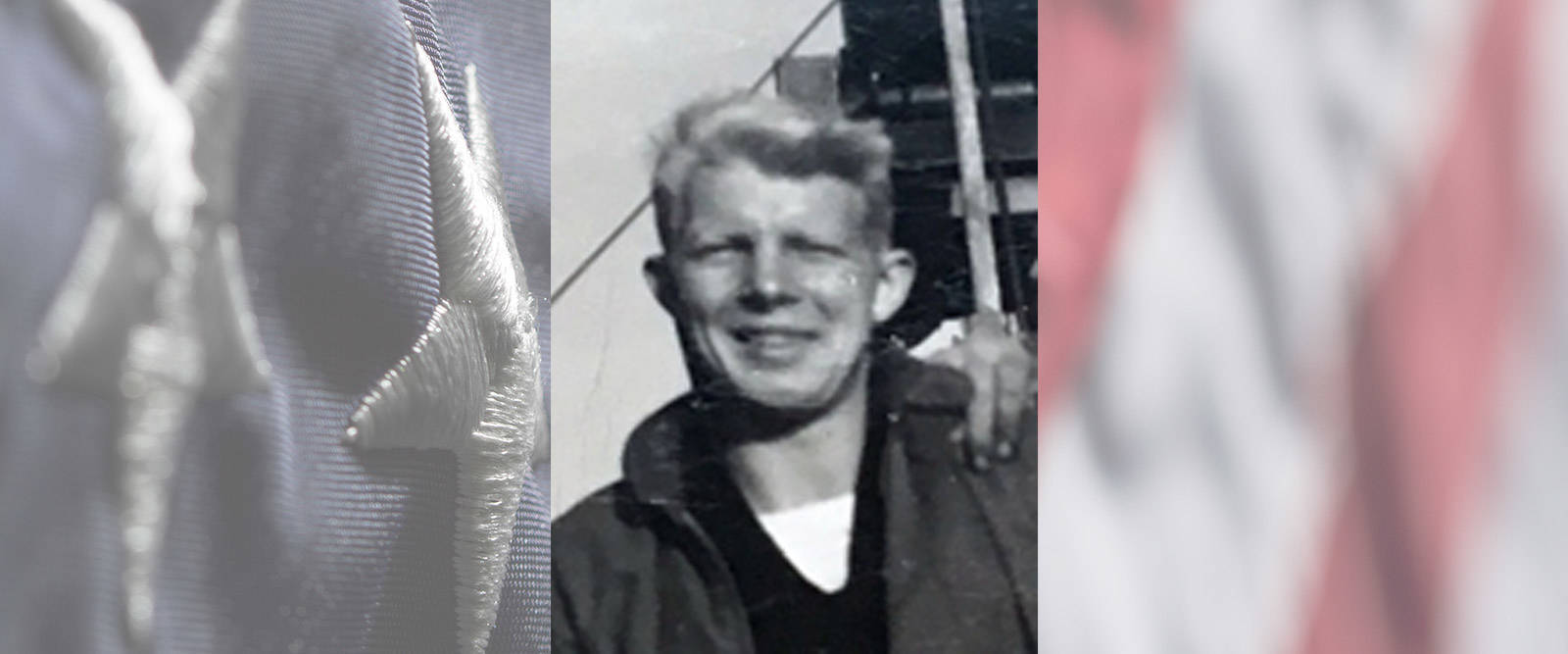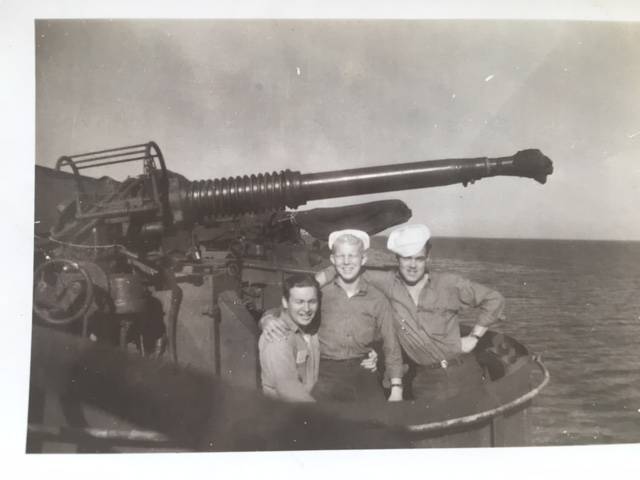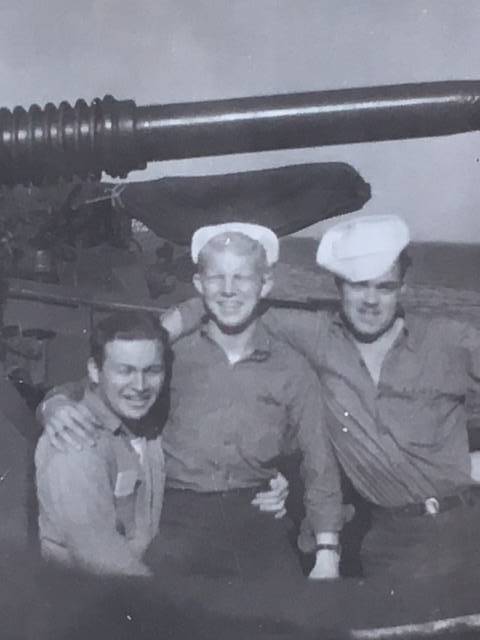U.S. Navy WWII Naperville, IL Flight date: 08/08/18
By April Horner, Honor Flight Chicago Veteran Interviews Volunteer
Harold “Hal” Dickson grew up in the quiet rural town of Maywood, New Jersey because his “wonderful parents” wanted their boys to live away from the big city. After graduating high school Hal did what all his friends were doing because “at the time, you had a responsibility.” So in September 1943 at age 17—and with the reluctant permission of his parents—he went to enlist.
The recruiting officer gave Hal a choice between the Army or Navy. He talked it over with his parents and chose the Navy because his dad said “in the Navy, you will never sleep in a dirty foxhole.” After signing up, he learned he’d have to take a color blindness test, and Hal is color blind. He stood in a long line waiting his turn and worrying about how he’d ever pass the test, knowing failure would disqualify him. As he took his seat he passed behind another recruit with the test and asked, “Can you read all those?” The obliging recruit quickly rattled off the answers, and Hal memorized them. He passed with flying colors! Later in the enlistment process, Hal was confronted with yet another color blindness test. This time an officer asked Hal, “Can you see the 7? Can you see the 6?” Again, Hal passed and was officially in the Navy. He completed basic training and torpedo specialist training in Newport, Rhode Island, which was a great location because his parents were close enough to visit him.
Hal’s first assignment was aboard the USS Schenck (DD-159), a vintage 1918 destroyer escort. Between November 1943 and January 1944, the Schenck was on hunt and kill missions in the Atlantic, searching for German submarines. General quarters, the call to man the battle stations, was sounded day and night. The Schenck crew would drop depth charges thinking they had found a sub, but often it was just a giant blackfish. They never saw evidence of a damaged sub, and Hal never once saw a German sailor while onboard. The Schenck also escorted supply ships bound for Europe and later protected troop transports moving up and down the east coast of the United States. His description of life aboard the old “four-stacker” is pretty dismal. When he wasn’t working, he lived under the main deck and his “sack,” as he calls it, was located next to the hull and so small he couldn’t even turn over. There was no head (bathroom) onboard, so relief of any kind was right over the side of the ship! The air smelled continually of diesel fumes. Guys would get drunk on “torpedo juice,” another name for torpedo fuel, and Hal was once dressed down for playing a song deemed too suggestive for the ship’s loudspeaker. Hal’s days were filled with routine duties as a member on the torpedo gang. He maintained, repaired, armed, and loaded the ship’s torpedoes. He also worked with the depth charge crew when he was needed and as a mess cook cleaning up in the kitchen and serving meals. Despite the less than comfortable conditions, Hal says the guys on the Schenck were like family.
Then, in June 1944, Hal was sent to Bermuda to serve on the USS Guadalcanal (CVE-60), the flagship aircraft carrier of the TG 22.3 Carrier/Destroyer Team, a hunt and kill group cruising the Atlantic. When Hal arrived the Guadalcanal had just docked after towing in the captured German submarine U505. The capture was a spectacular achievement for the Navy and the war effort. U505 is now on permanent display at Chicago’s Museum of Science and Industry. The men’s attention quickly returned to the business of war. The Guadalcanal sailed from Bermuda to Newport News, Virginia and went into dry dock. From June until July 15, 1944, Hal and the crew performed back-breaking work on her hull. They used hammers and chisels, ladders, and scaffolding to clean away debris and barnacles that slowed the ship down.
Hal says the Guadalcanal felt like a pleasure boat; it was like moving into an enormous hotel. There were movies, a barber shop, stores, bathrooms, showers, and lots of space. Compared to the Schenck, he had “acres of room” in his sack and could turn over if he wanted to! And he had a new job. He was now assigned to aviation ordnance on the “flat top.” Aviation ordnance men were responsible for the ship’s squadron of planes—TBMs, Corsairs, Curtis Avengers, and Wildcats to name a few. Hal cleaned guns, replaced guns, cleared ammunition jams, refilled ammunition, and cared for every aspect of airplane weaponry. It was dangerous work. Bullets would explode, there were sometimes serious accidents, and sailors got hurt. Hal lost a good friend on the flight deck when a tailhook cable snapped during a landing and fatally injured him. His friend’s death gave Hal a different perspective of what life meant that he carries with him till today.
During his time on the Guadalcanal, the ship made three hunt and kill cruises in the West Atlantic from July to December 1944. Hal says they could see subs from the deck, but they were not able to destroy any. On December 1, 1944, the Guadalcanal was reassigned to American and Caribbean waters to serve as a Navy pilot qualifying base. Navy fliers had to learn to take off and land on a flat top that was not only moving forward in the water, but sometimes rolling in choppy seas. Landing was a dangerous maneuver. Hal vividly remembers witnessing practice landings where “pilots made a lot of mistakes.” Many crashed on the deck, but some into the water. Hal described how pilots banking their planes to make the landing would sometimes catch the tip of the wing on the water’s surface causing the plane to somersault several times and then sink. It was horrible to watch because no one survived those mistakes. The crew was helpless to save a pilot once the plane went under water. Hal says he saw this happen many times, and it was hard to watch. The dangers of serving on the Guadalcanal were many.
Despite the hard work and incredible dangers, there were lots of good times in the Navy. He shook the hand of baseball Hall of Famer Ted Williams on the quarterdeck when Ted was going through pilot qualification. He met “a couple girls who were friendly” at the College of William and Mary, but he doesn’t remember their names. He does relish the memory of playing basketball when docked in American ports because the guys would play Marines and Navy teams at different bases. The Guadalcanal boys were the best among the Atlantic teams!
When he was discharged in December 1945, Hal distinctly remembers the lonely feeling of leaving the Navy. There he was in the Long Island, New York train station, all by himself “out in the civilian world.” After years of camaraderie among his shipmates, it felt strange riding the train back home to Maywood, New Jersey.
But his life took some bright turns after the Navy. He attended Fairleigh Dickinson University on the GI Bill and earned an engineering degree. In 1954 Hal met Marcia Whipple at a party. In February 1955 he made what he calls the best decision of his life: he married Marcia. Together they raised three children: Dan, Pam, and Lisa. Hal worked different jobs in concrete construction, but eventually settled in Minneapolis to work at the Pillsbury Company. In 1976 the Dickson family moved to Naperville where Hal started his own construction business, helping build the first section of the beautiful Naperville Riverwalk in 1981. Now the kids are grown and he lost Marcia in 2016. Hal stays busy reading and being involved with his church. He begins each day with daily devotionals, and he is very concerned about people. One of his goals is to do a better job of helping others.
For your dedicated service in the United States Navy we say thank you, Hal. Enjoy your much deserved day of honor in Washington, D.C.





